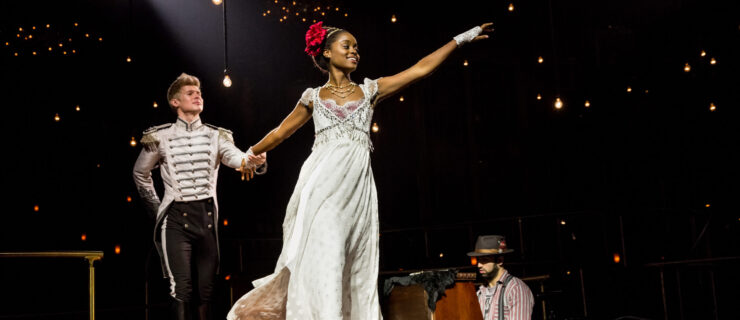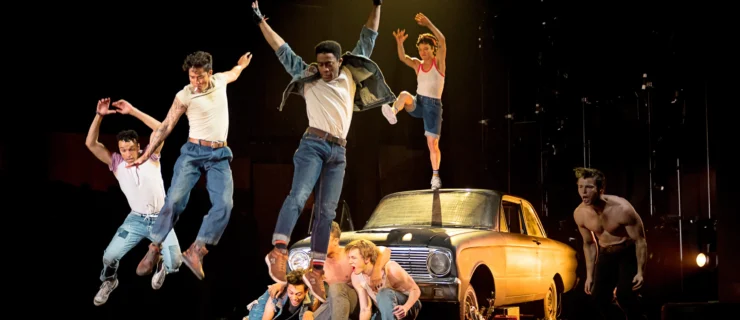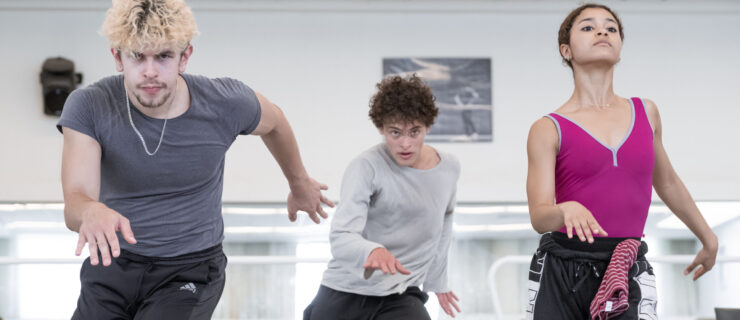Reviews
New York City Ballet
David H. Koch Theater, NYC • January 6–March 1, 2009 • Reviewed by Lisa Rinehart
During a winter of dire economic news, New York City Ballet’s season was comfy as a hot-water bottle on an aching tummy. An eyeful of beauty and an earful of glorious music, courtesy of the Balanchine repertory, ensured a good time for all. Under the sparkling waters, however, a seismic question churns: Is NYCB the keeper of the Balanchine flame, or is it a repertory company that just happens to feature Balanchine like, say, San Francisco Ballet, Miami City Ballet, Pacific Northwest Ballet, or fellow New York resident, American Ballet Theatre? These companies arguably perform Balanchine as well as (some say better than) NYCB, and all of them dance works by many of the world’s finest living choreographers. So what’s an artistic director to do? Based on a winter season featuring two new commissions, several non-Balanchine revivals, and some flaccid performances of Balanchine chestnuts, it appears that the choice is to totter uncomfortably in between.
Artistic director Peter Martins has commissioned numerous ballets for NYCB, but few have survived past their first season. This could be the result of bad luck––even talented choreographers can make flops––but it’s probably because of bad choices. Melissa Barak’s A Simple Symphony is a case in point. Promoting local talent is one thing, but Barak, a former NYCB dancer, has only a handful of ballets under her belt and apparently little awareness of anything beyond the realm of cloying neo-classic symmetry. A Simple Symphony is an unremarkable bit of cotton candy that just isn’t ready for prime time.
Lifecasting
by Douglas Lee, a principal dancer with the Stuttgart Ballet and two-time participant in NYCB’s New York Choreographic Workshop, is more sophisticated, but not necessarily better. The dancers are polished and aggressive under lighting either dim as a bar or bright as a meat case, but Lee doesn’t know what to do with the extraordinary appendages on display. The dance is a formless, pointless gymnastics exercise with the end signaled by nearly crushing the dancers with a cluster of hanging lights. I suspect Lee wanted to be sure we knew it was over.
Unfortunately, lackluster premieres such as these are more the norm than the exception at NYCB. Martins is unable to find the right choreographic talent for his company, or when he does, he can’t hang on to it. (The loss of Christopher Wheeldon as resident choreographer comes to mind, as do the clumsy negotiations that sent Alexei Ratmansky to ABT.) Perhaps an educational watching tour is in order before the next commissions are handed out.
Choreographic prowess isn’t at issue with the winter’s featured Balanchine repertory, but mediocre interpretations are. Listless performances from the corps through to the principals marred steely-boned works such as Concerto Barocco, Divertimento No. 15, Ballo della Regina, Theme and Variations, and, most egregiously, Stravinsky Violin Concerto. The corps, traditionally fired up by a coltish exuberance for the musicality and wit of Balanchine’s steps, looked clunky and uninterested. Worse, on occasion, principals were cast as though seniority alone might ensure depth of interpretation. Nilas Martins, barely in evidence for the season, showed up looking like someone’s lost uncle in Davidsbündlertänze, and even Robert Fairchild’s infectious joy couldn’t rescue Stravinsky Violin Concerto from a brittle Wendy Whelan and a matronly Yvonne Borree.
But now for the good news. NYCB’s dancers, including some veterans, are more versatile than ever. Whelan, though not up to the dramatic demands of Balanchine’s overly speedy Swan Lake, was magnificently feminine in Wheeldon’s After the Rain and Ratmansky’s Concerto DSCH. Sara Mearns, a powerhouse of a dancer capable of just about any technical trick, was transcendent in the tender first movement of Vienna Waltzes and a firecracker in the flamboyant finale of Brahms-Schoenberg Quartet. Hers will be an interesting trajectory to watch. The mercurial, almost dangerous Rebecca Krohn adds layers to all her roles, and Teresa Reichlen is a perfumed flower beginning to unfold. I will happily watch these two women dance anything in the repertory. As for the men, Daniel Ulbricht and Joaquin De Luz were consistently terrific and virtuosic enough to shine in a company less woman-centric than NYCB. Benjamin Millepied had an impressive season, dancing fully in everything from Theme and Variations to West Side Story to La Stravaganza. Philip Neal, usually cast as the (let’s just say it, boring) stalwart partner, surprised with flashy tap moves in Slaughter on Tenth Avenue and a darkly nuanced appearance in La Valse.
Of the season’s revivals, Robbins’ West Side Story Suite stretched the company farthest from its balletic roots, with Georgina Pazcoguin turning in a Tony Award-worthy performance as Anita. Jorma Elo’s 2006 Slice to Sharp held up well with a few cast changes. Gonzalo Garcia brought welcome elegance to Wheeldon’s uneven Mercurial Manoeuvres. And Megan Fairchild breathed new life into Balanchine’s Coppélia.
NYCB is looking good, but not as good as it needs to––more nimble and tour-ready companies are breathing down its lovely neck.
Ron K. Brown/Evidence
The Joyce Theater, NYC
February 10–15, 2009
Reviewed by Gus Solomons jr
Ronald K. Brown has evolved a distinctive voice in the dance world, combining West African, American modern, and club movement with text that comments on race, sexuality, and community. Brown’s works grace the repertories of most of the country’s Afro-centric concert dance companies, including the Alvin Ailey American Dance Theater. The appeal of his own troupe, Evidence, A Dance Company, lies in the dancers’ ownership of their skills and their bodies; they fearlessly assert powerful personalities.
The four women represent a refreshing range, from petite Lilli-Anne Tai to Clarice Young’s strong physique, to the shapelier Tiffany Quinn, to Francine Ott, a woman of size who exuberantly flaunts it. The men, all athletically built, range from compact Arcell Cabaug to six-foot-plus Otis Donovan Herring.
The six dances that Brown presented on two programs, spanning his career from 1995 to last year, share some structural elements. As my companion astutely put it, “His dances start in church and end in Africa.” The solemn openings of Ebony Magazine: to a village (1996) and Two-Year Old Gentlemen (2008)––a funeral ceremony and worship service, respectively––reinforce this impression. The second movements of both burst into joyful African-esque dancing.
In Ebony, dancers traverse the stage with rhythmic walking that erupts into lively arm-flapping, stag-leaping, and torso-pumping phrases.
A highlight of Two-Year Old Gentlemen is the guest appearance in the opening section of Ame Bender––older than 2, but no more than 4––as the embodiment of inchoate man, full of potential. One by one, he awakens Joel Sulé Adams, Herring, Cabaug, and Brown from repose and imitates their unison moves, jutting out his little arms and high-stepping smartly to the beat of onstage drumming. After he exits, the four men alternate show-off solos that seem at least partially improvisational, one-upping each other, but being deferential to the elder, Brown, dressed in white.
Incidents
(1998) and Grace (1999) open with long solos for a woman preceding the entrance of the others. In Incidents, Young and Ott dress a little girl, Tai, as if escorting her into womanhood, and then all four celebrate.
Grace
follows Young’s opening solo as a white-gowned priestess with exuberant dancing by the rest of the congregation in pairs and trios. In the second section, the dancers are all in profile, as if they were dancing for an audience in the wings.
Exotica
(1995) demonstrates Brown’s disco funky side. Lined up, women in front, men in back, everybody shakes their booties with attitude to the delight of the cadence-clapping audience.
Walking Out the Dark I
(2002) is one of Brown’s most satisfying dances; its architecture is classically simple. Four dancers anchor the corners of the stage. The women challenge each other; one crouches with outstretched hands, nose-to-nose, swiveling from side to side, fanning a leg in a wide circle. Their proximity threatens violence. Finally, the four walk out the dark rage and enter the light of mutual support and understanding.
Photo: Paul Kolnik, courtesy NYCB




